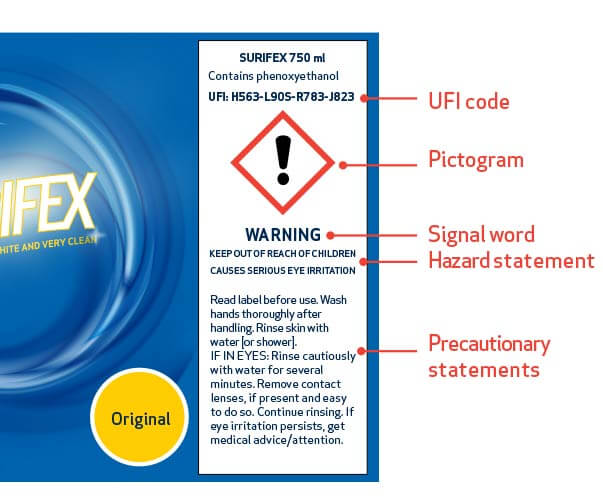What is the UFI code?
UFI stands for Unique Formula Identifier. It is an alphanumeric code comprising 16 characters. This code must be on the packaging of products if they contain hazardous mixtures and you sell them in EEA. It gets generated based on information such as the chemical composition, concentration, and toxicological data of the mixture.
UFI is not only a labeling requirement but also a key factor for poison centers in the EU. This helps poison centers quickly and accurately identify the composition of hazardous substances. Then they can provide correct instructions in case of emergencies.
The UFI code is encrypted data, and it cannot be easily accessible by the general public. Only the relevant authority of the member state gets informed of the data submitted. Therefore, you can confidently share the code with your distributors.
What products need a UFI number?
As part of the REACH regulations, UFI is primarily applied for hazardous mixtures sold or distributed in Europe. Common product categories include:
- Air Care Products. Different fragrance products, indoor deodorants, air fresheners, etc.
- Chemical Mixtures. E-cigarettes, printer inks, and toners, finger paints, adhesives, etc.
- Cleaning Products. Bathroom cleaners, laundry detergents, disinfectants, etc.
- Garden Chemicals and Building Materials. Plant fertilizers and pesticides, waterproof coatings, adhesives, etc.
Please note that cosmetics such as perfumes, lipsticks, hair dyes, etc., do not require a UFI code. Because they fall under different regulatory oversight.
What are the UFI code specifications for labels?
The UFI code consists of four main components:
- Company Identifier. Designated by ECHA, it identifies the company registering the product.
- Product Identifier. It is a unique identifier generated by the applicant for each product.
- Batch Number. It is used to identify specific product batches.
- Check Digit. It is calculated by a specific formula to ensure the accuracy of the UFI code.
The code follows a specific format. It should start with the prefix abbreviation “UFI”. Then it is followed by a 16-character alphanumeric code which is separated into four blocks with hyphens. All letters are uppercase, and letters that are difficult to distinguish from numbers are usually omitted.
According to regulations, the UFI code must be included in the SDS sheet. When printed on product packaging, it must be prominently visible. Typically it is near hazard information such as pictograms and safety instructions. Please note that the UFI code should never appear at the bottom of the packaging. However, for some products, especially those without product labels (e.g., industrial products), the UFI code may be specified only in the SDS.
Here is an example of a UFI code for your reference.
Source: poisoncenters
How to get the UFI code?
You can use ECHA’s UFI generator to automatically create a UFI, and the process is straightforward, requiring only two pieces of information
Your company’s VAT number.
The mixture-specific formulation number. You can choose this number associated with the product, such as a production batch number, product code, production date, etc. The formulation number should fall between 0 and 268 435 455.
Normally, mixtures with the same ingredients can use the same UFI code, even if the packaging or brand names are different. If you want to distinguish between different brands, the same mixture can have multiple UFIs. Please note that if the composition of the mixture changes, such as adjustments in proportions or the addition/removal of certain ingredients, you must update the UFI code promptly.
Additionally, after UFI registration, you will also need to complete poison center notifications (PCN). The poison center may require additional information, such as product name, ingredients, packaging, product category, and toxicological information, etc. The UFI becomes effective only after notification. Then it can be directly printed on product packaging and used for emergency response.
As a leading sourcing company in China, JingSourcing has helped 4000+ clients source and customize products directly from Chinese factories. If you want to import DG cargo or general products that contain hazardous materials, we will help you apply for the UFI code and prepare a series of certificates including SDS. Also, we have long-term cooperative freight forwarders and can offer you a competitive price to ship your goods.


Leave A Comment